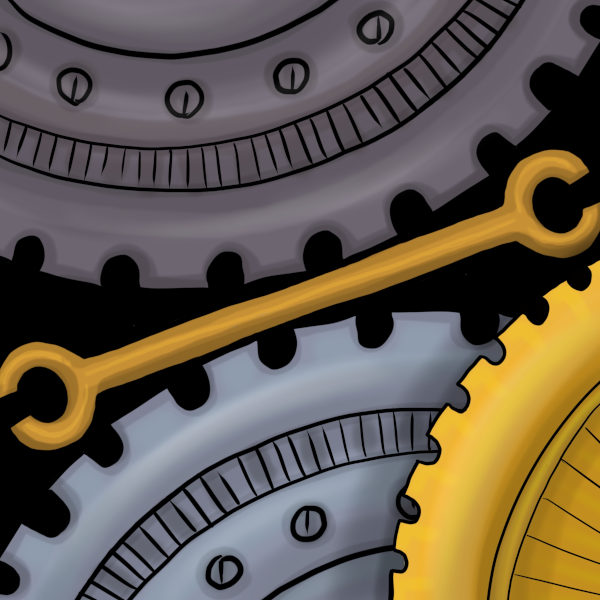This is an essay I wrote in 2022, inspired by Kyle Chaka’s 2016 viral essay, “Welcome to Airspace”. After seeing an excerpt from Kyle’s new book on the front of /c/Technology, I thought y’all might be interested in reading this piece of mine, which is less about the design of physical spaces, and more about The Algorithm™'s influence on creative practice in general.
This is a conversation I can have a million times, so I hope you enjoy.
Back in the day, both Harlan Ellison and Hunter Thompson wrote about the economics of being a writer. Around 1970 [iirc] Ellison said that if he sold one TV script a year he could pay his bills and write what he wanted. Thompson’s “Hell’s Angels” has a chapter on being a ‘drop out.’ A biker could get a Union stevedore job and save enough in six months to hit the road for two years. A part time waitress could keep herself and her musician boyfriend going.
I actually think that this is part of a larger phenomenon. It’s something that Adorno and Horkheimer identified all the way in the 1940s (in “Dialect of Enlightenment,” especially in the chapter “The Culture Industry”) that is now greatly accelerating because of computers. The result is what I call The Tyranny of Data. The essay isn’t that long and most of the length comes from examples, but I’ll try to do a super quick tl;dr of my argument. Here’s some Adorno and Horkheimer quotes that I cite:
For enlightenment, anything which does not conform to the standard of calculability and utility must be viewed with suspicion.
and
Bourgeois society is ruled by equivalence. It makes dissimilar things comparable by reducing them to abstract quantities. For the Enlightenment, anything which cannot be resolved into numbers, and ultimately into one, is illusion[.]
Basically, modern society culturally values arguments presented in numbers, especially when expressed in units of currency. I argue that now that we have computers, aka a machine capable of turning everything into numbers very easily, we can easily collapse everything into units of currency. This is a homogenizing and conservative (as in change averse) force (quoting myself):
You can measure how people feel about another Marvel movie, or a politician they already know, or whether they prefer this version or that version of a product. It’s much harder to measure interest in a brand new movie idea, or an unknown politician, or a radically new invention. The bigger the change, the harder it is to measure.
Because it’s so easy to turn things into numbers now, and because we culturally value data-based arguments as superior to other kinds, like moral or ideological, our collective ability to think in other ways is atrophying. As a result, we struggle to take the necessarily irrational risks that we need to take to make real progress, be it social progress, artistic progress, or whatever.
I go through a bunch of examples, like Joe Biden, who I call “a statistically generated median in corporeal form. He’s literally a franchise reboot, the single most derivative but fiscally sound cultural product.” I specifically talk about digital media too:
When deciding how much to value websites or podcasts or any other online media, we simply add up the number of downloads. No one actually thinks that’s a good way to decide the value of art, writing, journalism, story-telling, lascivious true crime blogs, or reality TV rewatch podcasts. It’s just the first number that fell out of a computer. Just like that, a complex social situation was transmuted into a number.
Fuck this is a great comment. Thank you.
Thanks! Plenty more like it
“Before you dismiss me as a curmudgeonly millennial in nostalgia-colored glasses, realize that I am not implying that art that falls closer to the “challenging” side of the accessibility spectrum has gone away, or that it has a smaller market share (though it wouldn’t surprise me) only that it does not bleed into the mainstream as often as it once did.”
This appears to be the thesis statement of the piece, but considering you’ve not defined what constitutes “mainstream” in any meaningful way or offered any evidence that the content of creative works entering this hypothetical “mainstream” are fundamentally more “safe” (another questionably valid construct) now than before 2008, all this whole thing really boils down to is anxiety over social media algorithms.
In order for your thesis to work, you’re going to have to explain why “algorithms” (who’s, exactly?) are going to lead artists to make worse stuff than what was approved by the average MBA nepotism hire that used to be responsible for gatekeeping what made it onto TV in the 90s. Because uh … we’ve seen a lot of that guy and an algo’s taste could hardly be worse. At least the algo can be influenced by what I like.
Also this image? Yeesh dude. A lot to unpack here. But suffice to say, people don’t make deeply challenging art because they crave clicks. They make it because they have to. Because it speaks to their soul or gives voice to their trauma. That’s not going to stop because they’re aware that shitty hotel art made with goofy materials gets more views on the TikToks. The phrase “spiritual growth in society becomes stunted” isn’t just jumping to conclusions; it’s multi-stage rocket launching to conclusions.
Ps. AirBnB literally never existed to provide a “rich cultural experience.” Come on.
Eh, what you’ve identified as the thesis is actually just a butt-covering footnote to prevent Reddit-style “ackchually” comments. When I wrote it I was still submitting posts to Reddit. I guess that’s on me for assuming the central point was more obvious.
genXers and older millennials will remember how this started happening to music on the radio around 1999 when ClearChannel started taking over every radio station in the US, effectively killing indie rock. all music had to become conformative pop trash, or it wouldn’t get radio play.
Something I think about a lot is how the “hipster” movement in the early 2000s was extremely anti- consumer culture. They were building easy to repair “fixie” bikes instead of driving cars, they were brewing their own beer and buying/mending clothes they bought second hand. They were moving to abandoned factory loft apartments in similarly abandoned urban areas.
Then, the artists living in lofts, making zines and and knitting sweaters got priced out. And now in pop culture the term “hipster” has largely replaced “yuppie” to mean an elitist, snobby, and extremely pro consumer culture sort of person, which is basically the opposite of what the young people in the early 2000s were doing. I’m not a conspiracy theorist but I have to imagine that the big corps saw the movement as a threat, and did an classic rebrand on them, like car companies did with the minivan to sell more SUVs.
Dissent is always eventually commodified in a capitalist system. Your hipster example is great but also think Black empowerment a la Beyonce. Just another trip to the simulacra
This is true of every artist scene eventually. The SoHo crowd from the 60s, the Beat generation in the 50s (North Beach and Greenwich village), Montparnasse in Paris in the 20s.
The artists of Rome where probably replaced in their neighborhoods by gentrification too, we just don’t have written proof. This isn’t some new fangled conspiracy. This is the cycle. Artists flock to cheap neighborhood and make it a famous cultural center with their art. Rich people want a piece of that atmosphere and move in eventually pricing out the artists they wanted to rub elbows with. Pretending this is a new phenomenon ignores the very nature of human society.
hipsters still exist, although i don’t think the name applies so much anymore.
For sure, they also don’t congregate in Williamsburg much anymore.
it’s not so much that we got priced out. many of us grew up and had kids (not me, ew), and the rest of us don’t want to be around those assholes anymore, lmao. coke-fueled drinking binges and after-hours parties don’t mix well with the kid life. so we all went to ft. greene, bed-stuy, and bushwick.






